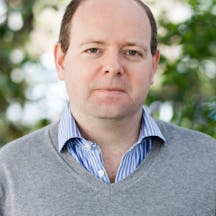Rickman Godlee’s operation on a brain tumour exemplifies why surgeons in Victorian times were famed for saying: “The operation was a success, but the patient died.” It was, however, a triumph of multidisciplinary teamwork, and an important landmark in neurology.
The mystery of the malignant brain
Words by Thomas Morrisartwork by Emily Evansaverage reading time 7 minutes
- Serial

Pioneering surgeons have often been portrayed as heroic individuals, but even the greatest of them worked as part of a team. Their breakthroughs would not have been possible without the surgical assistants, scrub nurses, anaesthetists and other skilled professionals who populate the operating theatre, and a technically perfect operation would be futile without expert nursing staff to coax the patient back to health.
But surgical innovation is also dependent on the skills of specialists whose work is done long before the patient arrives in the operating theatre. Diagnosing a rare or complex condition requires the knowledge of an experienced physician – who will often be able to give vital advice to the surgeon on how to treat it. And a novel operation is frequently the consequence of some fundamental new scientific insight from the laboratory, following years of research by physiologists striving to understand the mysteries of the human body.
Turning points in surgical history are more often ensemble pieces than virtuoso solo performances.

Sir Rickman John Godlee performing a surgical operation
A world first
There could hardly be a better illustration of such a grand alliance of expertise than the world’s first operation to remove a primary brain tumour. On 3 November 1884 a 25-year-old man was admitted to the Hospital for Epilepsy and Paralysis in London; little else is known about him except his surname (Henderson), and the fact that he was a farmer from Dumfries in Scotland.
Three years earlier he had noticed the muscles on the left side of his face sometimes twitched uncontrollably. These attacks became more frequent and then developed into serious convulsions, during which he lost consciousness. As the illness progressed he lost the use of his left arm, and by the time he arrived in hospital he was also suffering from excruciating headaches.
Despite large doses of morphine, Henderson’s headaches became so agonising that his cries kept the entire ward awake.
This combination of symptoms strongly suggested a brain tumour – and even 50 years earlier an experienced physician might have offered the same diagnosis. But how big was the tumour, and where in the skull would it be found? A decade before Henderson became ill these questions would have stumped even the most eminent specialists, but in 1884 the discipline of neurology was entering an exciting new era.

Internal view of the human brain from ‘The functions of the brain’, Ferrier, 1876.
Eight years previously the Scottish researcher David Ferrier had published his book ‘The Functions of the Brain’, which presented the results of thousands of experiments performed – controversially – on living animals. Ferrier used electrical stimulation and other techniques to prove that specific areas of the brain were responsible for controlling the movements of different parts of the body.
From this work he was able to construct a map, which related the anatomical features of the organ to its function – a revolutionary idea that became known as cerebral localisation. Using Ferrier’s maps, a clinician could interpret a patient’s symptoms by deducing which parts of the brain had been affected by disease.

Sir David Ferrier
Using a map to locate the tumour
Indeed, this is exactly what happened when Mr Henderson was seen by Alexander Hughes Bennett, a consultant neurologist at the Hospital for Epilepsy and Paralysis. Hughes Bennett was a friend of Ferrier and had made a detailed study of cerebral localisation. After listening to the Scot’s medical history, he examined him from head to toe, noting the tremor that affected the fingers of his left hand, the weakness of his left leg, and the strange twitch that began at the corner of his mouth and sent one side of his face into spasm.
The neurologist concluded that Henderson’s tumour was small, but growing. He even identified the part of the brain where he believed it could be found: a structure called the fissure of Rolando (now known as the central sulcus), a few inches above Henderson’s right ear.
For a few days the doctors struggled to treat their patient with drugs, but it was obvious that his condition was not improving. Despite large doses of morphine, Henderson’s headaches became so agonising that his cries kept the entire ward awake. Hughes Bennett recorded that “the terrible sufferings of the patient rendered life intolerable to him”, and acknowledged that without more drastic treatment he would not last much longer.
The only remaining option was an operation to remove the tumour from inside his brain, something that had never been done before. The terrible risks were made clear to Henderson, but he waved off the medics’ concerns: it was a chance he was willing to take.

Sir Rickman John Godlee
Godlee opens the skull
The surgeon who took on the formidable task was Rickman Godlee, a 35-year-old who already enjoyed a considerable reputation among his peers. He was the nephew of Joseph Lister, the surgeon whose use of antiseptics had dramatically reduced the incidence of postoperative infections. Godlee was a zealous advocate of his uncle’s methods, and nobody was more expert in their use.
Several of the country’s leading neurologists were in the operating theatre on 25 November to advise him, including Hughes Bennett and David Ferrier. Godlee had had some doubts about the wisdom of the procedure, but was reassured by the confidence of his eminent colleagues.
The patient, his head already shaved, was given chloroform, and once he was unconscious the procedure could begin. Hughes Bennett had provided the surgeon with a diagram indicating the likely location of the tumour; using this as a guide, Godlee made an opening in the man’s skull.
The surface of the brain looked healthy, and at first the doctors feared that their calculations had been incorrect. But a small incision in the brain matter revealed the tumour lying less than a centimetre beneath its surface – precisely where Hughes Bennett had indicated it would be. Godlee used his finger and then a metal spatula to separate it from the surrounding tissue and then carefully removed it.
The object that had caused Mr Henderson so much misery was a type of tumour known as a glioma; this specimen was about the size of a walnut.

Case of cerebral tumour, 1885
A temporary lease of life
Half an hour after surgery the patient was awake and drowsily answering questions; the medics were relieved to find that his intellect was unimpaired. Better still, the headaches and seizures had disappeared. Henderson’s left arm remained paralysed, the result of permanent damage wrought by the tumour, but in other respects he was cured. Sadly, however, his recovery was only temporary.
Throughout the two-hour operation, Godlee had taken the utmost care to prevent bacteria from getting into the wound. His assistants saturated the air with a fine mist of antiseptic spray that made their eyes and noses sting, and the bandages used to dress Henderson’s skull were impregnated with carbolic acid. But these precautions cannot have been perfect, because a few days after surgery their patient developed an infection.
With no antibiotics to stop its progress, there was little the doctors could do except clean the wound and hope. Two days before Christmas, Henderson succumbed to meningitis, a month after the operation that had so nearly saved him.
Godlee’s operation provoked considerable interest, as well as impassioned debate about the rights and wrongs of the animal research that had made it possible. It was soon regarded as the beginning of modern brain surgery – the first time that a tumour had been accurately located through symptoms alone, and the first time that a surgeon succeeded in removing a growth from inside the brain tissue.
It was also a triumph for multidisciplinary teamwork, a close-knit collaboration of research scientists and clinicians. The tragedy is that the patient, the most important member of this ensemble, did not survive to celebrate it.
About the contributors
Thomas Morris
Thomas Morris is author of ‘The Matter of the Heart’ and more recently ‘The Mystery of the Exploding Teeth and Other Curiosities from the History of Medicine’. He has worked as a radio producer for the BBC on such programmes as ‘Front Row’, ‘Open Book’ and Melvyn Bragg’s ‘In Our Time’, and his journalism has appeared in publications including the Lancet and the Times.
Emily Evans
Emily Evans is a medical illustrator and anatomist. After her role as a senior demonstrator of anatomy at Cambridge University, alongside her career illustrating medical and surgical books for over a decade, she now writes and publishes books about anatomy and art, such as ‘Anatomy in Black’, while running her brand, Anatomy Boutique.

